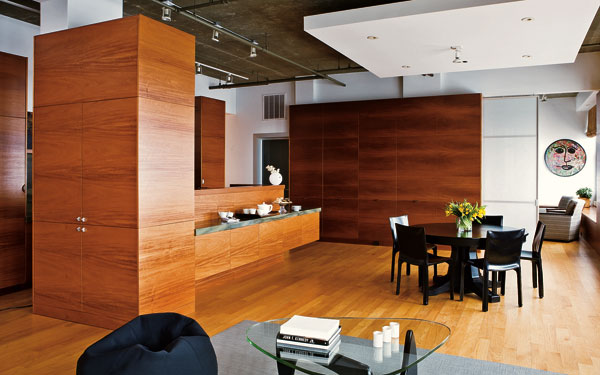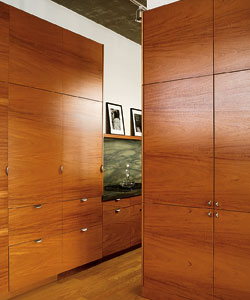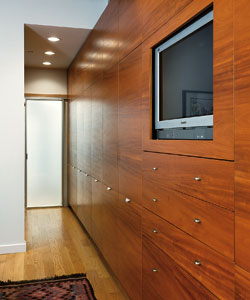
All houses have secrets. Not all have beautiful places to hide them. But here, in a converted warehouse loft overlooking the river, Claudia Skylar of Chicago’s Mastro & Skylar Architects (mastroskylararchitects.com) designed cleverly hidden storage right into the DNA of the architecture.
Her clients were downscaling to this one-bedroom apartment from a large house and frankly, they had a lot of stuff. Skylar says she approached the place like a chess player, deliberating over her moves to respond to her clients’ needs and take advantage of the opportunity to cover up exposed pipes and ducts while doing so. Here are some lessons learned:
Storage can be sexy
Cabinets of mahogany, its satiny grain laid horizontally, shimmer throughout the apartment, lending a unified look of sleek geometry to the place while subtly defining individual areas. A cabinet between the kitchen and living room holds trays, platters, and serving pieces (the owners love to entertain); it also separates the living space from the cooking area. Cabinets were kept to a height of nine feet in this loft with 11-foot ceilings; the space above them enhances a feeling of openness. The wood’s warm color and horizontal grain draw the eye around the rooms and keep things on a human scale.
Fatten up your walls
Skylar sculpted the loft’s living areas within a landscape of extra-wide walls that harbor a range of storage options-shelves, drawers, and closets. The capacious cabinets also hide unsightly pipes and other démodé 1980s-style industrial features. "Exposed ducts in lofts like this used to be considered wonderful; now they are a bit of a cliché," says Skylar. "But everyplace we had to hide some of those mechanicals, we gave our clients storage space. Even if it was only nine inches deep, it became a place to put wine glasses or small salad plates."
Establish a rhythm
An open bookshelf or cabinet appears at regular intervals along the window wall overlooking the river. "We needed the bookcase in the den because we were hiding ducts behind it, but the one between the dining and living spaces was necessary for symmetry," says Skylar. Sliding doors between the rooms help lend proportion and balance to the cabinets. Made of translucent glass, they slide open from the center of the cabinets. When all of the doors are open, the space feels like one big room.
 |
|
Kitchen cabinets match the ones extending into the living room, for a seamless visual flow. |
You don’t have to spell it out
Kitchen storage continues out into the living room, but who would know? When a cabinet has the same mahogany veneer as the refrigerator door, there is a lot of flexibility as to what goes where. In a den that doubles as a guest bedroom for the couple’s grown sons, one wall performs multiple duties as TV cabinet, clothes closet, bookshelf, and bureau.
Beware the hardware
"If I didn’t have to have cabinet pulls at all, I wouldn’t," says Skylar. "They can look messy. But push locks tend to break, they don’t always close completely, and with a lot of use the finish of the wood can wear." For this loft she chose modern satin nickel pulls that "aren’t kitchen-like, so they work in the bedroom, too." Upper cabinets, which Skylar calls "dead storage" because they store things that are used infrequently, were left pull-less. "You can pull them open from the bottom," says Skylar. "And we gave our clients a beautiful mahogany ladder as a housewarming gift, for climbing up there.
Reconsider the sideboard
"We made the island multi-level to function as a buffet for the dining table," says Skylar. "There’s more storage under the buffet, and the half-wall behind the buffet hides the kitchen’s dirty dishes from dinner guests." The tall cabinet attached to the cabinet hides mechanicals.
 |
|
A wall in the bedroom holds a TV, custom fitted drawers, and generous hanging space for clothes. There’s a built-in dresser on an opposite wall, and an ingenious little office and technology area hiding behind another. "All that messy stuff (computers, wires) is out of sight." |
Banish the medicine cabinet
"I just don’t like conventional medicine cabinets," says Skylar. "Even the high-end standard ones come in limited sizes. I like to create furniture instead." For this project, she attached mahogany consoles with sliding glass doors to the walls of the three bathrooms. "We put outlets on the inside so appliances can be hidden along with all the other necessary bathroom items, and on the top you could place a candle or a vase of flowers," says Skylar. "Very civilized."
Everything is illuminated
Skylar positioned the track lighting system on the raw concrete ceiling so that brightness can be thrown directly into the cabinets when they’re opened, illuminating the whole interior at once.
Boot the hard drive
Skylar created an ingenious little four-foot-wide office and technology area behind one of the bedroom walls. "We pulled out the wall that the bed sits against and then built shelves and a computer desk back there," says Skylar. "All that messy stuff is out of sight."
For resource information, see Buyers Guide.
Photography: Nathan Kirkman


